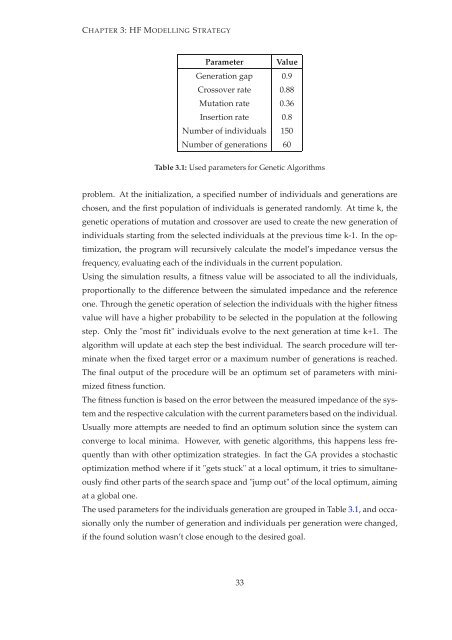PDF (Thesis) - Nottingham eTheses - University of Nottingham
PDF (Thesis) - Nottingham eTheses - University of Nottingham
PDF (Thesis) - Nottingham eTheses - University of Nottingham
You also want an ePaper? Increase the reach of your titles
YUMPU automatically turns print PDFs into web optimized ePapers that Google loves.
CHAPTER 3: HF MODELLING STRATEGY<br />
Parameter Value<br />
Generation gap 0.9<br />
Crossover rate 0.88<br />
Mutation rate 0.36<br />
Insertion rate 0.8<br />
Number <strong>of</strong> individuals 150<br />
Number <strong>of</strong> generations 60<br />
Table 3.1: Used parameters for Genetic Algorithms<br />
problem. At the initialization, a specified number <strong>of</strong> individuals and generations are<br />
chosen, and the first population <strong>of</strong> individuals is generated randomly. At time k, the<br />
genetic operations <strong>of</strong> mutation and crossover are used to create the new generation <strong>of</strong><br />
individuals starting from the selected individuals at the previous time k-1. In the op-<br />
timization, the program will recursively calculate the model’s impedance versus the<br />
frequency, evaluating each <strong>of</strong> the individuals in the current population.<br />
Using the simulation results, a fitness value will be associated to all the individuals,<br />
proportionally to the difference between the simulated impedance and the reference<br />
one. Through the genetic operation <strong>of</strong> selection the individuals with the higher fitness<br />
value will have a higher probability to be selected in the population at the following<br />
step. Only the "most fit" individuals evolve to the next generation at time k+1. The<br />
algorithm will update at each step the best individual. The search procedure will ter-<br />
minate when the fixed target error or a maximum number <strong>of</strong> generations is reached.<br />
The final output <strong>of</strong> the procedure will be an optimum set <strong>of</strong> parameters with mini-<br />
mized fitness function.<br />
The fitness function is based on the error between the measured impedance <strong>of</strong> the sys-<br />
tem and the respective calculation with the current parameters based on the individual.<br />
Usually more attempts are needed to find an optimum solution since the system can<br />
converge to local minima. However, with genetic algorithms, this happens less fre-<br />
quently than with other optimization strategies. In fact the GA provides a stochastic<br />
optimization method where if it "gets stuck" at a local optimum, it tries to simultane-<br />
ously find other parts <strong>of</strong> the search space and "jump out" <strong>of</strong> the local optimum, aiming<br />
at a global one.<br />
The used parameters for the individuals generation are grouped in Table 3.1, and occa-<br />
sionally only the number <strong>of</strong> generation and individuals per generation were changed,<br />
if the found solution wasn’t close enough to the desired goal.<br />
33
















